Petrol–electric transmission
Petrol–electric transmission (UK English) or gasoline–electric transission or gas–electric transmission (US English) is a transmission system for vehicles powered by petrol engines. Petrol-electric transmission was used for a variety of applications in road, rail, and marine transport, in the early 20th century. After World War I, it was largely superseded by diesel-electric transmission, a similar transmission system used for diesel engines; but petrol-electric has become popular again in the 21st century in hybrid electric vehicles.
Petrol–electric transmission was used in certain niche markets in the early 20th century, such as in the petrol–electric railway locomotives produced in Britain for use on the War Department Light Railways during World War I or for privately owned Arad & Csanad United Railways. In France, the Crochat petrol–electric transmission system was used for standard gauge locomotives (up to 240kW of electrical power).
Description
Petrol-electric transmission works by converting the mechanical force of the petrol engine into electrical energy (through a dynamo), and using the electrical energy to drive traction motors, which propel the vehicle mechanically. The traction motors may be driven directly or via a rechargeable battery; if the latter method is used, the vehicle is classed as a hybrid vehicle.
Advantages and disadvantages
Petrol–electric transmission allows smooth, stepless, acceleration without gear changes. The disadvantages are increased cost and weight.
Historical applications
Road
Examples of road vehicles using petrol–electric transmission include the Tilling-Stevens bus (UK) and the Owen Magnetic touring car (USA).
 Tilling-Stevens petrol–electric bus
Tilling-Stevens petrol–electric bus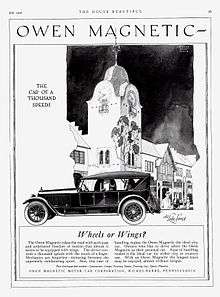 Owen Magnetic touring car 1920 advertisement
Owen Magnetic touring car 1920 advertisement St. Chamond tank
St. Chamond tank
Rail
Examples of petrol–electric rail vehicles include the North Eastern Railway 1903 Petrol Electric Autocar, Doodlebug (rail car),GE 57-ton gas-electric boxcab,[1] Weitzer railmotor and the petrol–electric locomotives built for the War Department Light Railways by Dick, Kerr & Co. and British Westinghouse.[2] In France, the Crochat-Colardeau system of Henry Crochat and Emmanuel Colardeau was used in some petrol–electric railcars.
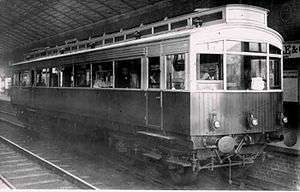 North Eastern Railway Autocar at Filey Station
North Eastern Railway Autocar at Filey Station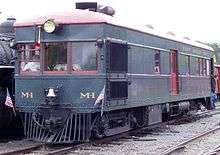 Gas–electric "Doodlebug" railcar
Gas–electric "Doodlebug" railcar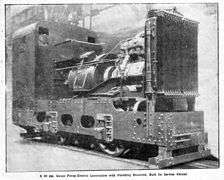 Dick, Kerr & Co. petrol electric locomotive under construction
Dick, Kerr & Co. petrol electric locomotive under construction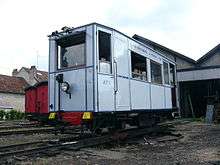 Crochat petrol electric railcar preserved at Pithiviers
Crochat petrol electric railcar preserved at Pithiviers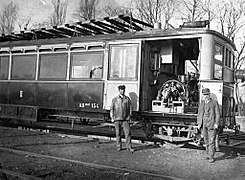 Weitzer railmotor produced for ACsEV
Weitzer railmotor produced for ACsEV
Marine
Most submarines that served in World War I were diesel–electric. However, some petrol–electric submarines had been built before the war. Examples include: Plunger-class submarine (USA),[3] A-class submarine (1903) (UK),[4] SM U-1 (Austria-Hungary), Russian submarine Krab (1912).
 USS Plunger S2-1
USS Plunger S2-1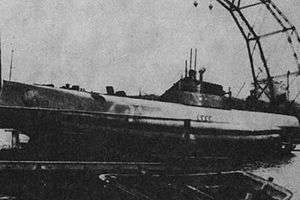 Russian submarine Krab
Russian submarine Krab
Military vehicles
Petrol–electric systems were tested on the British Mark II tank, American Holt gas electric tank and French Saint Chamont in 1917. The latter used the Crochat-Colardeau system of Henry Crochat and Emmanuel Colardeau. This allowed the left and right traction motors to run at different speeds for steering and is detailed in patent US1416611.[5] The 1936 prototype Char G1P was also designed with a petrol–electric drive.[6]
Ferdinand Porsche was the main developer of these drive trains for military vehicles in Nazi Germany. He created the VK 3001 (P) prototype and VK 4501, of which 91 units were produced as the Porsche Tiger.[7] They were later converted into Ferdinand, and subsequently Elefant, tank destroyers.[8] Another noteworthy design was the 188-tonne Porsche type 205 prototypes, commonly known as the Maus super-heavy tank.
Modern applications
In the 21st century, petrol–electric transmission has gained a new lease of life in hybrid electric vehicles. Examples include: Ford Fusion Hybrid; Honda Civic Hybrid; Toyota Prius.
See also
- Electric transmission (mechanical)
- Petrol-electric transmission
- Turbine-electric transmission
- Turbo-electric transmission
References
- "Archived copy". Archived from the original on 2015-02-14. Retrieved 2015-02-14.CS1 maint: archived copy as title (link)
- Davies, W.J.K. (1967). Light Railways of the First World War. David and Charles. pp. 157–159.
- "Submarine Photo Index".
- "MaritimeQuest - A Class (1902) Submarines Class Overview".
- "Espacenet - Original document".
- Steven J. Zaloga (2014). French Tanks of World War II (1). Osprey. ISBN 9781782003922.
- Thomas L Jentz (1997). Panzerkampfwagen VI P (Sd.Kfz.181): The history of the Porsche Typ 100 and 101 also known as the Leopard and Tiger (P). Darlington Productions. ISBN 978-1892848031.
- "Ferdinand/Elephant". Achtung Panzer. Retrieved 2010-02-07.